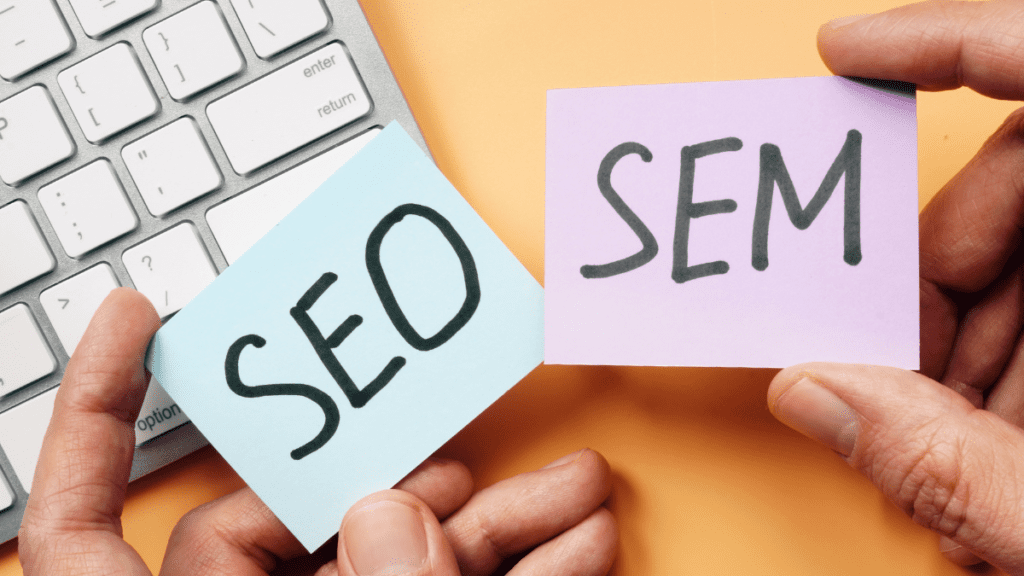SEO and SEM: A Comprehensive Overview
In today’s digital marketing, SEO and SEM are vital. They can make or break your online presence. As a business owner, you must know these strategies. They can mean the difference between a steady stream of customers and being lost online. Think of SEO as a master mapmaker. It guides users to your site with its expert use of keywords and content. SEM is like a targeted ad. It uses paid ads to direct users to your site. By harnessing the power of both, you can unlock the full potential of your online brand. This blog post will explore SEO and SEM. It will highlight their pros and cons. It will also offer tips on combining them into your marketing strategy.
Understanding SEO and SEM
What is SEO?
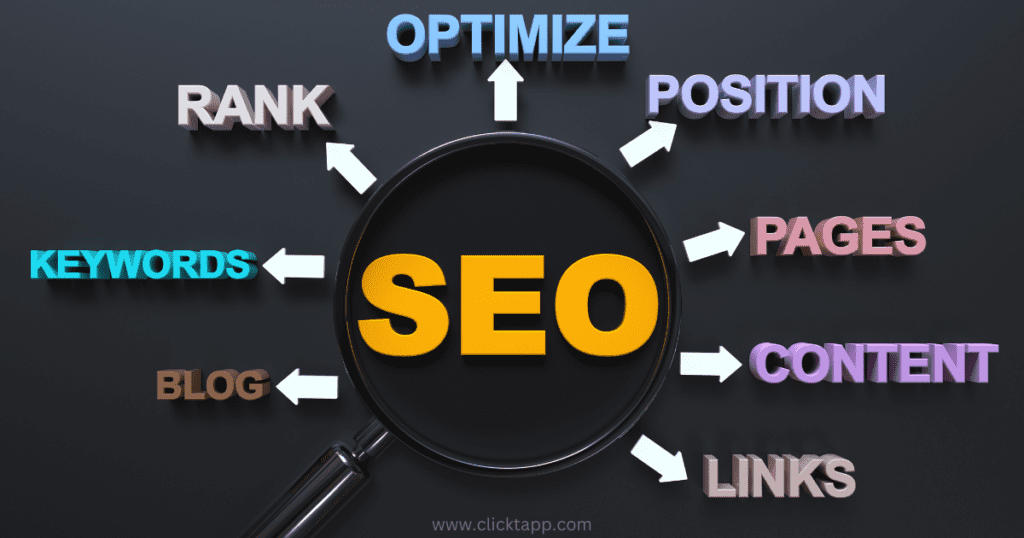
SEO, or Search Engine Optimization, is a strategy. It aims to improve a website’s rank in search results. This increases its visibility online. This approach has many parts. It involves improving a website’s design, content, and code. The goal is to make it more appealing to search engines and relevant to specific keywords. This can help websites rank higher for their target keywords. As a result, they will get more organic traffic. For example, a user searching for “best Italian restaurants in New York City” would find a top result. It would be a site about a top Italian restaurant in Manhattan. It would be well optimized. This would attract diners. Optimizing their website can help businesses boost their online presence. It will reach a wider audience and drive more sales.
Key components of SEO:
- On-page SEO: optimization of content, meta tags, headers, and internal links.
- Off-Page SEO: Building backlinks, social signals, and domain authority.
- Technical SEO: Improving website speed, mobile friendliness, and crawlability.
- Content Creation: Crafting high-quality, relevant, and engaging content.
What is SEM?
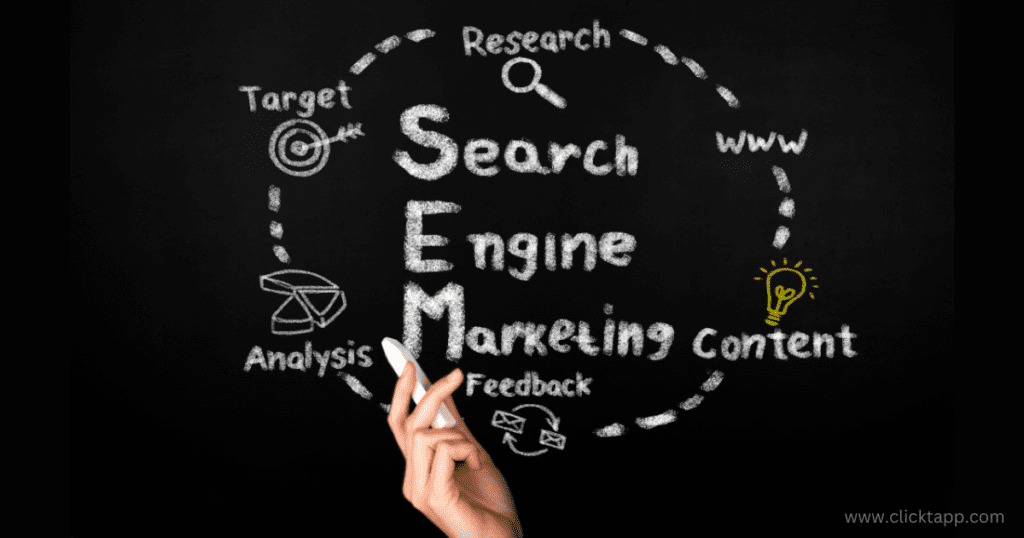
Search Engine Marketing (SEM) is a powerful online ad strategy. It uses paid tactics to boost a website’s visibility on search engine results pages (SERPs). SEM, linked to PPC ads, is a way to target specific audiences. It boosts high-quality leads and drives immediate traffic. For instance, a fashion brand can use SEM to target holiday “winter coats” searchers. This will get their website to the top of search results and drive traffic to their online store. SEM helps businesses boost their online presence and reach their target audience. It drives conversions and sales.
Key Components of SEM:
- Paid Search Ads: Displaying ads on search engines like Google and Bing.
- Keyword Targeting: Selecting high-performing keywords for campaigns.
- Ad Copy Optimization: Crafting compelling ad copies to boost click-through rates (CTR).
- Budget Management: Allocating funds effectively to maximize return on investment (ROI).
SEO vs. SEM: A Comparative Analysis

Time Frame for Results
- SEO: Results take time, often months, as search engines evaluate content and backlinks.
- SEM: Delivers immediate visibility and traffic once campaigns are live.
Cost Implications
- SEO: Primarily involves time and resources for content creation and optimization.
- SEM: Involves ongoing costs for ad campaigns, with costs varying based on competition.
Longevity of Impact
- SEO: long-term strategy with lasting benefits.
- SEM: short-term visibility that ends when the budget is exhausted.
Click-Through Rates (CTR)
- SEO: Users tend to trust organic results more. This boosts CTR for top-ranking pages.
- SEM: Paid ads can have lower CTR due to user skepticism.
Best Use Cases
- SEO: Ideal for businesses seeking sustainable growth and authority in their niche.
- SEM: Perfect for short-term campaigns, product launches, or targeting competitive keywords.
Mastering SEO: Tips and Best Practices
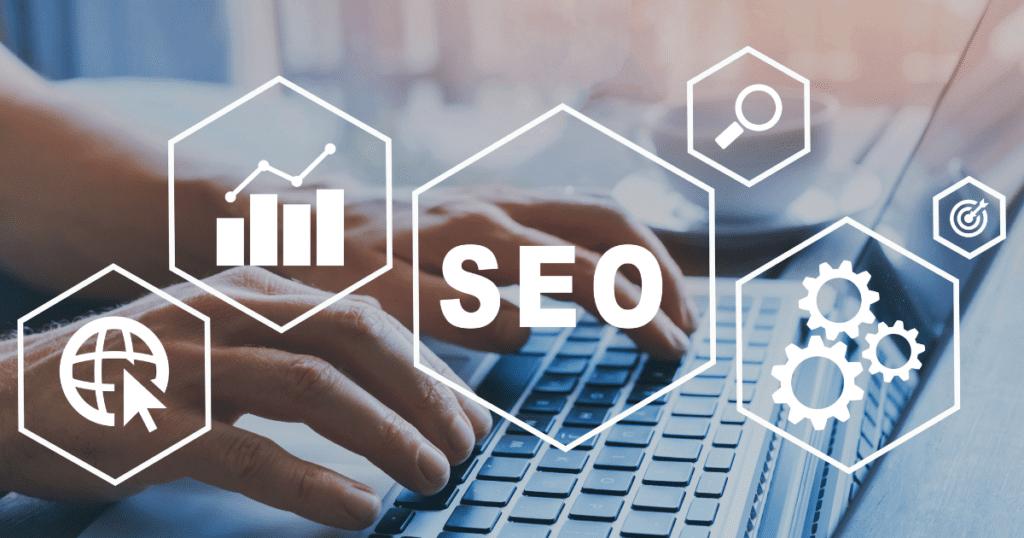
1. Conduct Comprehensive Keyword Research
Keywords are the foundation of SEO. Use tools like Google Keyword Planner, SEMrush, or Ahrefs. They can help you find keywords that have high search volume but low competition.
2. Optimize On-Page Elements
Ensure titles, meta descriptions, headers, and content are optimized with target keywords. Use variations and synonyms naturally within the content.
3. Focus on Technical SEO
Website speed, mobile optimization, and HTTPS are key. They affect rankings.
4. Build High-Quality Backlinks
Earn backlinks from authoritative websites through guest posting, collaborations, or creating shareable content.
5. Check and Analyze Performance
Use Google Analytics and Google Search Console to track performance. They can help find areas for improvement.
Mastering SEM: Tips and Best Practices
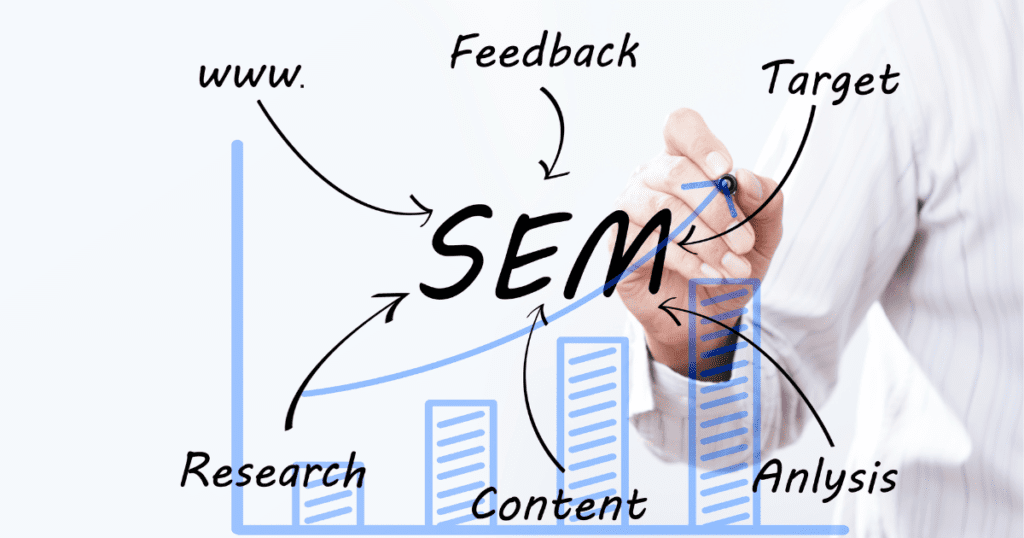
1. Set Clear Objectives
Define the goals of your SEM campaign, whether it’s brand awareness, lead generation, or sales.
2. Choose the Right Keywords
Bid on keywords that have a high search volume but low competition. This will optimize costs.
3. Craft Compelling Ad Copy
Create attention-grabbing headlines, persuasive descriptions, and clear calls-to-action (CTAs).
4. Leverage Ad Extensions
Use ad extensions, such as site links and call buttons. They boost visibility and engagement.
5. Continuously Test and Optimize
Run A/B tests on ad copies, keywords, and landing pages to identify what works best.
Integrating SEO and SEM for Maximum Impact
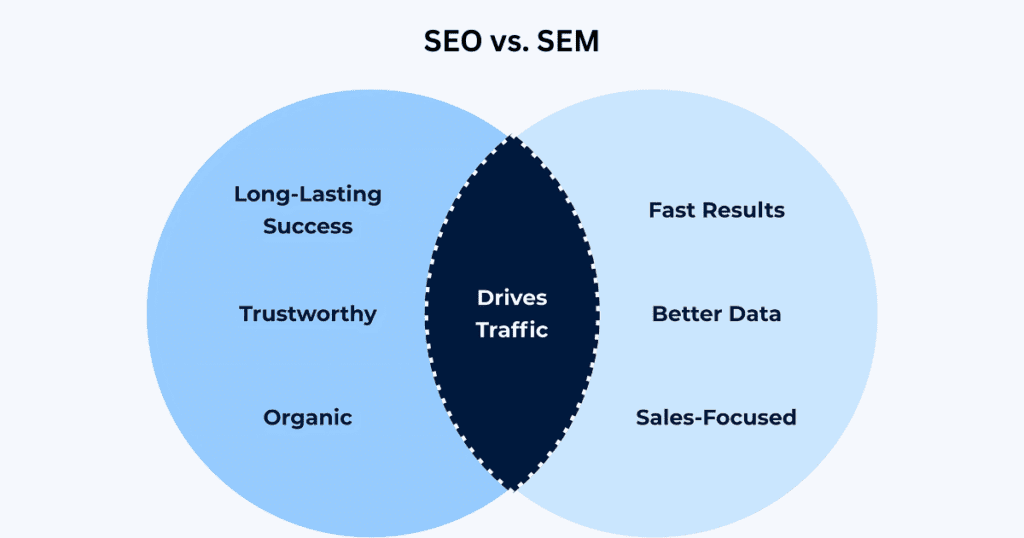
Combining SEO and SEM strategies can yield synergistic benefits. Here’s how:
1. Data Sharing
SEM campaigns provide valuable insights into high-performing keywords, which can inform SEO strategies.
2. Holistic Visibility
Using both organic and paid strategies can help your brand dominate SERPs. This will boost its credibility and traffic.
3. Cost Efficiency
SEM gives fast results. SEO leads to lasting growth. It balances short- and long-term investments.
4. Enhanced Content Strategy
SEM data can guide content creation. It helps align with user intent and search trends.
Measuring Success in SEO and SEM
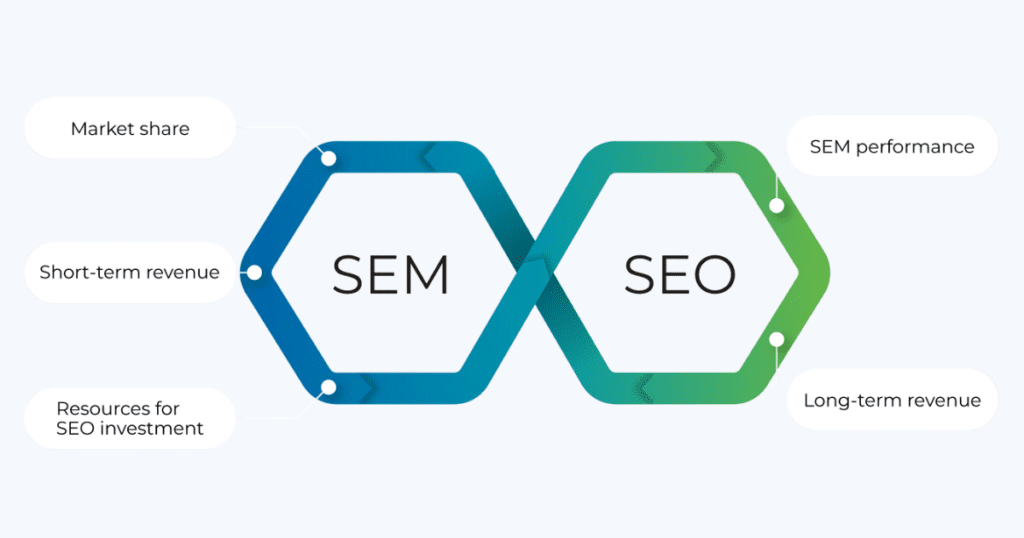
Key Metrics for SEO
- Organic Traffic
- Keyword Rankings
- Bounce Rate
- Backlink Profile
- Domain Authority
Key Metrics for SEM
- Click-through rate (CTR)
- Conversion Rate
- Cost-per-click (CPC)
- Quality Score
- Return on Ad Spend (ROAS)
Challenges and How to Overcome Them
1. Algorithm Updates
Search engines frequently update algorithms, which impacts SEO strategies. Stay informed and adapt quickly.
2. High Competition
SEM can be costly in competitive niches. Focus on long-tail keywords and precise targeting to optimize costs.
3. Keeping Up with Trends
Both SEO and SEM must continuously be learning. Follow industry blogs, attend webinars, and network with experts.
Conclusion
SEO and SEM are indispensable tools in the digital marketing arsenal. While they serve distinct purposes, their integration can drive unparalleled success. Businesses can navigate digital marketing with confidence. They just need to know their strengths and use best practices. This will ensure growth and a competitive edge. To grow your brand online, master SEO and SEM. They are the keys to organic growth and visibility.
Here are 10 important FAQs about SEO and SEM, complete with answers:
1. What is the main difference between SEO and SEM?
SEO aims to improve organic search visibility through optimization. SEM uses paid strategies, like PPC, for quick traffic.
2. How long does it take to see results with SEO?
SEO is a long-term strategy. Depending on competition and optimization, it takes 3 to 6 months to see results.
3. Are SEO and SEM strategies mutually exclusive?
No, they complement each other. SEO gives lasting results, while SEM offers quick visibility. So, they work well together.
4. What are some free tools for the SEO analysis?
Popular tools include Google Analytics, Google Search Console, Ubersuggest, and Moz. They are free.
5. How does Quality Score impact SEM campaigns?
Quality Score rates your ads and keywords for relevance and quality. It affects ad placement and cost per click (CPC).
6. What is the role of keywords in SEO and SEM?
Keywords are central to both strategies. They guide SEO content and SEM ads.
7. Is SEM effective for small businesses with limited budgets?
Yes, small businesses can run cheap SEM campaigns. They should target niche keywords and focus on local audiences.
8. How can I measure the success of my SEO efforts?
Track metrics like organic traffic and keyword rankings. Also, track the bounce rate and domain authority. Use tools like Google Analytics and SEMrush for this.
9. What is the average cost of SEM campaigns?
Costs vary by industry and competition. The average CPC ranges from $1 to $3 for Google Ads, but it can be higher in competitive markets.
10. Can I run SEM campaigns without professional help?
Yes, Google Ads has easy-to-use tools. But expert help leads to better results. It optimizes ads and boosts ROI.

